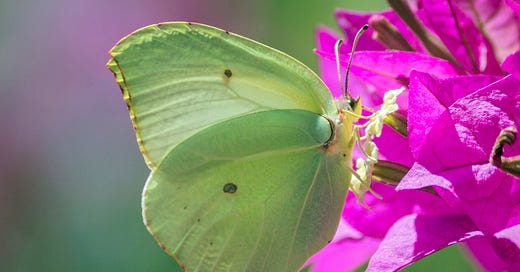One Planet News: The Brimstone butterfly and the miracle of metamorphosis
Brimstone butterflies - a sign of spring
By Annette J Beveridge
Who doesn't love to see the beautiful yellow brimstone butterfly with its distinctive leaf-shaped wings? Brimstones are one of the first butterflies to appear in the year and, for me, is a sign that the darker days of winter are fading and spring is on its way.
Adult brimstone butterflies hibernate in winter and have a natural anti-freeze in their blood. This is essential for their survival but on warmer days in the emerging year, the butterflies may be seen flying and are a common sight in spring.
Found in damp woodlands and mature hedgerows, the larvae feast on buckthorn and alder buckthorn.
The brimstone is a large butterfly with characteristic pointed wings which appear veiny. Males are a lemon-yellow, and females a greenish white. An orange spot can be seen in the middle of the wings. When resting, the wings are closed.
The word brimstone means sulphur. It describes the male’s acid yellow and green wings. Females are often mistaken for cabbage whites.
Adult butterflies feed on nectar using a long proboscis. They are able to feed on flowers beyond the reach of other butterflies on plants such as teasel. If you want brimstone butterflies, make sure you have buckthorn or alder buckthorn for the larvae and plant bluebells as the flowers provide a much-needed early source of nectar. They are especially attracted to purple flowers.
Tell the world how much you care for nature with our eco-inspired T-shirts.
Brimstones can live for a year in their adult form with adults travelling to mate in spring. Fertilised eggs are laid beneath a buckthorn leaf.
New adults emerge from their chrysalis in July.
Brimstones will often be seen in pairs flitting along hedgerows or gardens or spiralling upwards and then falling downwards to mate.
Learn about the wonders of metamorphosis next.
Keep reading with a 7-day free trial
Subscribe to One Planet News to keep reading this post and get 7 days of free access to the full post archives.




